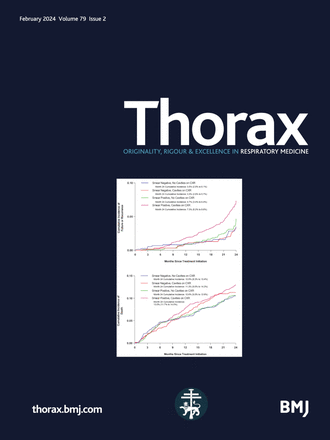Air pollution, genetic susceptibility and risk of progression from asthma to COPD
IF 7.7
1区 医学
Q1 RESPIRATORY SYSTEM
引用次数: 0
Abstract
Background In the UK, an estimated 15% of asthma patients have concurrent chronic obstructive pulmonary disease (COPD), yet the underlying causes and mechanisms remain largely unexplored. This study aimed to investigate the roles of both ambient air pollution and genetic susceptibility in the progression from asthma to COPD. Methods 46 832 participants with asthma were recruited from the UK Biobank during the baseline period (2006–2010). Particulate matter with a diameter of 2.5 μm (PM2.5) and nitrogen dioxide (NO2) were estimated at baseline address using land-use regression models. Air pollution score reflected joint exposure to air pollution. Polygenic risk score was calculated using novel genetic signals identified for coexistence of asthma+COPD. Cox proportional hazards regression analysis was employed to quantify the risks of both ambient air pollution and genetic scores on incident COPD among asthmatics, adjusting for covariates. Results Over a median follow-up of 10.84 years, 3759 participants with asthma at baseline developed COPD. For an IQR increase in PM2.5 and NO2, the HR for developing COPD was 1.07 (95% CI: 1.02 to 1.11) and 1.10 (95% CI: 1.04 to 1.15), respectively. Adverse effects could be observed at concentrations as low as 8 µg/m3 for PM2.5 and 12 µg/m3 for NO2. A significant multiplicative interaction was identified between ambient air pollution and genetic susceptibility. Individuals with the highest genetic risk score exhibited the greatest risk, with an HR of 1.13 (95% CI: 1.05 to 1.22) per IQR increase in air pollution score (P interaction <0.05). Conclusions Ambient air pollution is strongly associated with progression from asthma to comorbidity COPD, particularly among individuals with high genetic risk. Data are available on reasonable request.空气污染、遗传易感性和从哮喘发展为慢性阻塞性肺病的风险
在英国,估计有15%的哮喘患者同时患有慢性阻塞性肺疾病(COPD),但其潜在原因和机制在很大程度上仍未被探索。本研究旨在探讨环境空气污染和遗传易感性在哮喘发展为慢性阻塞性肺病中的作用。方法在基线期(2006-2010年)从英国生物银行(UK Biobank)招募46832名哮喘患者。利用土地利用回归模型估算了基线地址下直径为2.5 μm的颗粒物(PM2.5)和二氧化氮(NO2)。空气污染得分反映了联合暴露在空气污染中的情况。使用鉴定出的哮喘+COPD共存的新遗传信号计算多基因风险评分。采用Cox比例风险回归分析来量化环境空气污染和遗传评分对哮喘患者COPD发病的风险,并对协变量进行调整。结果在10.84年的中位随访中,3759名基线哮喘患者发展为COPD。对于PM2.5和NO2的IQR增加,发展为COPD的HR分别为1.07 (95% CI: 1.02至1.11)和1.10 (95% CI: 1.04至1.15)。PM2.5浓度低至8µg/m3, NO2浓度低至12µg/m3时,可观察到不良影响。环境空气污染与遗传易感性之间存在显著的乘法交互作用。遗传风险评分最高的个体表现出最大的风险,空气污染评分每增加1 IQR,风险比为1.13 (95% CI: 1.05 ~ 1.22) (P交互作用<0.05)。结论:环境空气污染与哮喘发展为COPD共病密切相关,特别是在高遗传风险人群中。如有合理要求,可提供资料。
本文章由计算机程序翻译,如有差异,请以英文原文为准。
求助全文
约1分钟内获得全文
求助全文
来源期刊

Thorax
医学-呼吸系统
CiteScore
16.10
自引率
2.00%
发文量
197
审稿时长
1 months
期刊介绍:
Thorax stands as one of the premier respiratory medicine journals globally, featuring clinical and experimental research articles spanning respiratory medicine, pediatrics, immunology, pharmacology, pathology, and surgery. The journal's mission is to publish noteworthy advancements in scientific understanding that are poised to influence clinical practice significantly. This encompasses articles delving into basic and translational mechanisms applicable to clinical material, covering areas such as cell and molecular biology, genetics, epidemiology, and immunology.
 求助内容:
求助内容: 应助结果提醒方式:
应助结果提醒方式:


